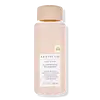What's inside
What's inside
 Key Ingredients
Key Ingredients

No key ingredients
 Benefits
Benefits

 Concerns
Concerns

 Ingredients Side-by-side
Ingredients Side-by-side

Water
Skin ConditioningBrassica Alcohol
EmollientCetearyl Alcohol
EmollientStearyl Alcohol
EmollientPropanediol
SolventCetyl Alcohol
EmollientBrassicyl Isoleucinate Esylate
Emulsion StabilisingPrunus Amygdalus Dulcis Oil
Skin ConditioningPersea Gratissima Oil
Skin ConditioningAloe Barbadensis Leaf Juice
Skin ConditioningHydrolyzed Corn Protein
Skin ConditioningHydrolyzed Wheat Protein
Skin ConditioningHydrolyzed Soy Protein
HumectantPhenoxyethanol
PreservativeIsododecane
EmollientCetyl Esters
EmollientBehentrimonium Chloride
PreservativeIsopropyl Myristate
EmollientCetrimonium Chloride
AntimicrobialGuar Hydroxypropyltrimonium Chloride
Skin ConditioningPanthenol
Skin ConditioningCitric Acid
BufferingLeuconostoc/Radish Root Ferment Filtrate
AntimicrobialWater, Brassica Alcohol, Cetearyl Alcohol, Stearyl Alcohol, Propanediol, Cetyl Alcohol, Brassicyl Isoleucinate Esylate, Prunus Amygdalus Dulcis Oil, Persea Gratissima Oil, Aloe Barbadensis Leaf Juice, Hydrolyzed Corn Protein, Hydrolyzed Wheat Protein, Hydrolyzed Soy Protein, Phenoxyethanol, Isododecane, Cetyl Esters, Behentrimonium Chloride, Isopropyl Myristate, Cetrimonium Chloride, Guar Hydroxypropyltrimonium Chloride, Panthenol, Citric Acid, Leuconostoc/Radish Root Ferment Filtrate
Water
Skin ConditioningSodium Laureth Sulfate
CleansingCocamidopropyl Betaine
CleansingSodium Lauryl Sulfate
CleansingSodium Chloride
MaskingParfum
MaskingPhenoxyethanol
PreservativeSodium Sulfate
Glycerin
HumectantDisodium EDTA
PEG-4 Laurate
EmulsifyingPEG-4 Dilaurate
EmulsifyingCitric Acid
BufferingTetrasodium EDTA
Cetearamidoethyldiethonium Succinoyl Hydrolyzed Pea Protein
CleansingIodopropynyl Butylcarbamate
PreservativePEG-4
HumectantHypnea Musciformis Extract
Skin ProtectingSargassum Filipendula Extract
Skin ProtectingSorbitol
HumectantGelidiella Acerosa Extract
Skin ProtectingMethylchloroisothiazolinone
PreservativeCaprylic/Capric Triglyceride
MaskingChamomilla Recutita Flower Extract
MaskingHelianthus Annuus Seed Oil
EmollientMangifera Indica Seed Butter
Skin ConditioningPersea Gratissima Oil
Skin ConditioningRicinus Communis Seed Oil
MaskingMethylisothiazolinone
PreservativeCoco-Glucoside
CleansingEthylhexylglycerin
Skin ConditioningAlgin
MaskingCarrageenan
Chitosan
Guar Hydroxypropyltrimonium Chloride
Skin ConditioningSorbitan Oleate
EmulsifyingXanthan Gum
EmulsifyingLimonene
PerfumingCI 17200
Cosmetic ColorantWater, Sodium Laureth Sulfate, Cocamidopropyl Betaine, Sodium Lauryl Sulfate, Sodium Chloride, Parfum, Phenoxyethanol, Sodium Sulfate, Glycerin, Disodium EDTA, PEG-4 Laurate, PEG-4 Dilaurate, Citric Acid, Tetrasodium EDTA, Cetearamidoethyldiethonium Succinoyl Hydrolyzed Pea Protein, Iodopropynyl Butylcarbamate, PEG-4, Hypnea Musciformis Extract, Sargassum Filipendula Extract, Sorbitol, Gelidiella Acerosa Extract, Methylchloroisothiazolinone, Caprylic/Capric Triglyceride, Chamomilla Recutita Flower Extract, Helianthus Annuus Seed Oil, Mangifera Indica Seed Butter, Persea Gratissima Oil, Ricinus Communis Seed Oil, Methylisothiazolinone, Coco-Glucoside, Ethylhexylglycerin, Algin, Carrageenan, Chitosan, Guar Hydroxypropyltrimonium Chloride, Sorbitan Oleate, Xanthan Gum, Limonene, CI 17200
 Reviews
Reviews

Ingredients Explained
These ingredients are found in both products.
Ingredients higher up in an ingredient list are typically present in a larger amount.
Citric Acid is an alpha hydroxy acid (AHA) naturally found in citrus fruits like oranges, lemons, and limes.
Like other AHAs, citric acid can exfoliate skin by breaking down the bonds that hold dead skin cells together. This helps reveal smoother and brighter skin underneath.
However, this exfoliating effect only happens at high concentrations (20%) which can be hard to find in cosmetic products.
Due to this, citric acid is usually included in small amounts as a pH adjuster. This helps keep products slightly more acidic and compatible with skin's natural pH.
In skincare formulas, citric acid can:
While it can provide some skin benefits, research shows lactic acid and glycolic acid are generally more effective and less irritating exfoliants.
Most citric acid used in skincare today is made by fermenting sugars (usually from molasses). This synthetic version is identical to the natural citrus form but easier to stabilize and use in formulations.
Read more about some other popular AHA's here:
Learn more about Citric AcidThis ingredient is derived from guar gum.
It is a conditioning ingredient, meaning it helps soften skin and hair.
Persea Gratissima Oil is also known as avocado oil.
Avocado Oil has antioxidant properties. It is mostly made up of the glycerides of fatty acids. About 67% of these fatty acids is made up of oleic acid. Palmitic acid and linoleic acid are also present.
These fatty acids help hydrate and soften the skin. It may increase collagen content in the skin. Collagen helps keep your skin plump and firm. This ingredient helps reduce inflammation and has not shown to clog pores.
This ingredient may not be fungal-acne safe due to its high fatty acid content.
Avocados also have B vitamins, vitamin K, vitamin C, vitamin E, and potassium.
Learn more about Persea Gratissima OilPhenoxyethanol is a preservative that has germicide, antimicrobial, and aromatic properties. Studies show that phenoxyethanol can prevent microbial growth. By itself, it has a scent that is similar to that of a rose.
It's often used in formulations along with Caprylyl Glycol to preserve the shelf life of products.
Water. It's the most common cosmetic ingredient of all. You'll usually see it at the top of ingredient lists, meaning that it makes up the largest part of the product.
So why is it so popular? Water most often acts as a solvent - this means that it helps dissolve other ingredients into the formulation.
You'll also recognize water as that liquid we all need to stay alive. If you see this, drink a glass of water. Stay hydrated!
Learn more about Water